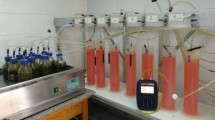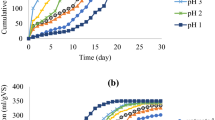Abstract
This study aimed to investigate the impact of dilute acid-thermal pretreatment of horse manure (HM) on the characteristic changes followed by biomethanation of untreated (control) and pretreated HM using iron oxide (Fe3O4) nanoparticles (NPs) as additives at concentrations of 20 mg/L, 40 mg/L and 60 mg/L at mesophilic (35 ± 2 °C) and thermophilic (55 ± 2 °C) temperature conditions. The acid-thermal pretreatment enabled the depolymerisation of the lignocellulosic crystalline structure of HM resulting in the reduction of cellulose and hemicellulose by 93 % and 96 % respectively. Addition of deficient or surplus concentration of NPs or micronutrients may adversely influence the activity of microbes because the release of key enzymes is ion dependant. Addition of appropriate concentration of Fe3O4 NPs facilitates the release of Fe2+ and Fe3+ ions that contribute to the release of key enzymes, but the addition of surplus concentration results in the release of reactive and toxic-free radicals or intermediates that decline the activity of the microorganisms. Results disclosed that the maximum methane yield of 0.16 L/g CODreduced and 0.175 L/g CODreduced was achieved under mesophilic and thermophilic conditions from pretreated HM with an addition of 40 mg/L of Fe3O4 NPs with a COD reduction of 68 % and 56 %, respectively, whereas it was 0.14 L/g CODreduced and 0.15 L/g CODreduced with an addition of 60 mg/L of Fe3O4 NPs with corresponding COD reduction of 58 % and 62.5 %, respectively, from untreated HM. Based on the findings achieved in the study, it is proven that the HM is a potential feedstock for biogas/methane generation. Incorporating the advanced techniques such as acid-thermal pretreatment and addition of supplements in the form of NPs further enhances the biomethanation process making it more lucrative and feasible for implementation at full scale.

Graphical abstract





Similar content being viewed by others
References
Hadin A, Eriksson O, Hillman K (2016) A review of potential critical factors in horse keeping for anaerobic digestion of horse manure. Renew Sust Energ Rev 65:432–442. https://doi.org/10.1016/j.rser.2016.06.058
Sun L, Pope P, Eijsink V, Schnurer A (2015) Characterization of microbial community structure during continuous anaerobic digestion of straw and cow manure. Microb Biotechnol 8(5):815–827. https://doi.org/10.1111/1751-7915.12298
Monch-Tegeder M, Lemmer A, Oechsner H (2014) Enhancement of methane production with horse manure supplement and pretreatment in a full-scale biogas process. Energy 73:523–530. https://doi.org/10.1016/j.energy.2014.06.051
Wartell BA, Krumins V, Alt J, Kang K, Schwab BJ, Fennell DE (2012) Methane production from horse manure and stall waste with softwood bedding. Bioresour Technol 112:42–50. https://doi.org/10.1016/j.biortech.2012.02.012
Airaksinen S, Heinonen-Tanski H, Heiskanen ML (2001) Quality of different bedding materials and their influence on the compostability of horse manure. J Equine Vet 21(3):125–130. https://doi.org/10.1016/s0737-0806(01)70108-6
Abdelwahab TAM, Mohanty MK, Sahoo PK, Behera D (2020) Application of nanoparticles for biogas production: current status and perspectives. Energy Sources, Part A: Recovery, Utilization, and Environmental Effects:1–13. https://doi.org/10.1080/15567036.2020.1767730
Sawatdeenarunat C, Surendra KC, Takara D, Oechsner H, Khanal SK (2015) Anaerobic digestion of lignocellulosic biomass: challenges and opportunities. Bioresour Technol 178:178–186. https://doi.org/10.1016/j.biortech.2014.09.103
Kim J, Park C, Kim T, Lee M, Kim S, Kim S, Lee J (2003) Effects of various pretreatments for enhanced anaerobic digestion with WAS. J Biosci Bioeng 95(3):271–275. https://doi.org/10.1016/s1389-1723(03)80028-2.
Mostofian B, Cai CM, Smith MD, Petridis L, Cheng X, Wyman CE, Smith JC (2016) Local phase separation of Co-solvents enhances pre-treatment of biomass for bioenergy applications. J Am Chem Soc 138(34):10869–10878. https://doi.org/10.1021/jacs.6b03285
Shirkavand E, Baroutian S, Gapes DJ, Young B (2016) Combination of fungal and physicochemical processes for lignocellulosic biomass pre-treatment A review. Renew Sust Energ Rev 54:217–234. https://doi.org/10.1016/j.rser.2015.10.003
Shuai L, Amiri MT, Questell Santiago YM, Heroguel F, Li Y, Kim H, Meilan R, Chapple C, Ralph J, Luterbacher JS (2016) Formaldehyde stabilization facilitates lignin monomer production during biomass depolymerization. Science. 354(6310):329–333. https://doi.org/10.1126/science.aaf7810
Narron RH, Kim H, Chang H, Jameel H, Park S (2016) Biomass pre-treatments capable of enabling lignin valorization in a biorefinery process. Curr Opin Biotechnol 38:39–46. https://doi.org/10.1016/j.copbio.2015.12.018
Kuruti K, Gangagni Rao A, Gandu B, Kiran G, Mohammad S, Sailaja S, Swamy YV (2015) Generation of bioethanol and VFA through anaerobic acidogenic fermentation route with press mud obtained from sugar mill as a feedstock. Bioresour Technol 192:646–653. https://doi.org/10.1016/j.biortech.2015.05.104
Choong YY, Norli I, Abdullah AZ, Yhaya MF (2016) Impacts of trace element supplementation on the performance of anaerobic digestion process: a critical review. Bioresour Technol 209:369–379. https://doi.org/10.1016/j.biortech.2016.03.028
Demirel B, Scherer P (2011) Trace element requirements of agricultural biogas digesters during biological conversion of renewable biomass to methane. Biomass Bioenergy 35:992–998. https://doi.org/10.1016/j.biombioe.2010.12.022
Pobeheim H, Munk B, Johansson J, Guebitz GM (2010) Influence of trace elements on methane formation from a synthetic model substrate for maize silage. Bioresour Technol 101:836–839. https://doi.org/10.1016/j.biortech.2009.08.076
Takashima M, Shimada K, Speece RE (2011) Minimum requirements for trace metals (iron, nickel, cobalt, and zinc) in thermophilic and mesophilic methane fermentation from glucose. Water Environ Res 83:339–346. https://doi.org/10.2175/106143010x12780288628895
Zhang Y, Feng Y, Quan X (2015) Zero-valent iron enhanced methanogenic activity in anaerobic digestion of waste activated sludge after heat and alkali pretreatment. Waste Manag 38:297–302. https://doi.org/10.1016/j.wasman.2015.01.036
Khanal SK, Huang JC (2006) Online oxygen control for sulfide oxidation in anaerobic treatment of high-sulfate wastewater. Water Environ Res 78(4):397–408. https://doi.org/10.2175/106143006x98804
Okoro OV, Sun Z (2019) Desulphurisation of biogas: a systematic qualitative and economic-based quantitative review of alternative strategies. ChemEngineering 3(3):76. https://doi.org/10.3390/chemengineering3030076
Abdelsalam E, Samer M, Attia YA, Abdel Hadi MA, Hassan HE, Badr Y (2016) Comparison of nanoparticles effects on biogas and methane production from anaerobic digestion of cattle dung slurry. Renew Energy 87:592–598. https://doi.org/10.1016/j.renene.2015.10.053
Casals E, Barrena R, Garcia A, Gonzalez E, Delgado L, Busquets Fite M, Font X, Arbiol J, Glatzel P, Kvashnina K, Sanchez A, Puntes V (2014) Programmed iron oxide nanoparticles disintegration in anaerobic digesters boosts biogas production. Small. 10(14):2801–2808. https://doi.org/10.1002/smll.201303703
Dehhaghi M, Tabatabaei M, Aghbashlo M, Panahi HKS, Nizami AS (2019) A state-of-the-art review on the application of nanomaterials for enhancing biogas production. J Environ Manag 251:109597. https://doi.org/10.1016/j.jenvman.2019.109597
Juntupally S, Begum S, Allu SK, Nakkasunchi S, Madugul M, Anupoju GR (2017) Relative evaluation of micronutrients (MN) and its respective nanoparticles (NPs) as additives for the enhanced methane generation. Bioresour Technol 238:290–295. https://doi.org/10.1016/j.biortech.2017.04.049
Wang Y, Wang D, Fang H (2018) Comparison of enhancement of anaerobic digestion of waste activated sludge through adding nano-zero valent iron and zero valent iron. RSC Adv 8:27181–27190. https://doi.org/10.1039/c8ra05369c
Tabatabaei M, Aghbashlo M, Valijanian E, Kazemi Shariat Panahi H, Nizami AS, Ghanavati H, Sulaiman A, Mirmohamadsadeghi S, Karimi K (2019) A comprehensive review on recent biological innovations to improve biogas production, part 1: upstream strategies. Renew Energy 146:1204–1220. https://doi.org/10.1016/j.renene.2019.07.047
Sekoai PT, Ouma CNM, Du Preez SP, Modisha P, Engelbrecht N, Bessarabov DG, Ghimire A (2019) Application of nanoparticles in biofuels: an overview. Fuel 237:380–397. https://doi.org/10.1016/j.fuel.2018.10.030
Rahimzadeh H, Tabatabaei M, Aghbashlo M, Panahi HKS, Rashidi A, Goli SAH, Mostafaei M, Ardjmand M, Nizami AS (2018) Potential of acid-activated bentonite and SO3H-functionalized MWCNTs for biodiesel production from residual olive oil under biorefinery scheme. Front Energy Res 6:137–147. https://doi.org/10.3389/fenrg.2018.00137
Ali A, Mahar RB, Soomro RA, Sherazi STH (2017) Fe3O4 nanoparticles facilitated anaerobic digestion of organic fraction of municipal solid waste for enhancement of methane production. Energy Sources, Part A: Recovery, Utilization and Environmental Effects 39:1815–1822. https://doi.org/10.1080/15567036.2017.1384866
Ambuchi JJ, Zhang Z, Feng Y (2016) Biogas enhancement using iron oxide nanoparticles and multi-wall carbon nanotubes. Int J Chem Biomol Eng 10:1305–1311
Abdelsalam E, Samer M, Attia YA, Abdel-Hadi MA, Hassan HE, Badr Y (2017) Effects of Co and Ni nanoparticles on biogas and methane production from anaerobic digestion of slurry. Energy Convers Manag 141:108–119. https://doi.org/10.1016/j.enconman.2016.05.051
Ma D, Wang J, Chen T, Shi C, Peng S, Yue Z (2015) Iron-oxide-promoted anaerobic process of the aquatic plant of curly leaf pondweed. Energy Fuel 29:4356–4360. https://doi.org/10.1021/acs.energyfuels.5b00573
Metcalf I (2003) Wastewater Engineering; Treatment and Reuse, fourth edn. McGraw-Hill, Boston
Temizel I, Emadian SM, Di Addario M, Onay TT, Demirel B, Copty NK, Karanfil T (2017) Effect of nano-ZnO on biogas generation from simulated landfills. Waste Manag 63:18–26. https://doi.org/10.1016/j.wasman.2017.01.017
Garcia A, Delgado L, Torà JA, Casals E, González E, Puntes V, Font X, Carrera J, Sánchez A (2012) Effect of cerium dioxide, titanium dioxide, silver, and gold nanoparticles on the activity of microbial communities intended in wastewater treatment. J Hazard Mater 199:64–72. https://doi.org/10.1016/j.jhazmat.2011.10.057.
Yu B, Shan A, Zhang D, Lou Z, Yuan H, Huang X, Zhu N, Hu X (2015) Dosing time of ferric chloride to disinhibit the excessive volatile fatty acids in sludge thermophilic anaerobic digestion system. Bioresour Technol 189:154–161. https://doi.org/10.1016/j.biortech.2015.03.144
Facchin V, Cavinato C, Fatone F, Pavan P, Cecchi F, Bolzonella D (2013) Effect of trace element supplementation on the mesophilic anaerobic digestion of foodwaste in batch trials: the influence of inoculum origin. Biochem Eng J 70:71–77. https://doi.org/10.1016/j.bej.2012.10.004
Yan X, Wang Z, Zhang K, Si M, Liu M, Chai L, Liu X, Shi Y (2017) Bacteria-enhanced dilute acid pre-treatment of lignocellulosic biomass. Bioresour Technol 245:419–425. https://doi.org/10.1016/j.biortech.2017.08.037
APHA (1998) Standard methods for the examination of water and wastewater, 20th edn. APHA, AWWA, WEF, Washington D.C
Sluiter A, Hames B, Ruiz R, Scarlata C, Sluiter J, Templeton D, Crocker DLAP (2008) Determination of structural carbohydrates and lignin in biomass. Laboratory analytical procedure 1617(1):1–16. http://www.nrel.gov/biomass/analytical-procedures.html. Accessed 20 Aug 2020
Berger P, Adelman NB, Beckman KJ, Campbell DJ, Ellis AB, Lisensky GC (1999) Preparation and properties of an aqueous ferro fluid. J Chem 76(7):943. https://doi.org/10.1021/ed076p943
Neshat SA, Mohammadi M, Najafpour GD, Lahijani P (2017) Anaerobic co-digestion of animal manures and lignocellulosic residues as a potent approach for sustainable biogas production. Renew Sust Energ Rev 79:308–322. https://doi.org/10.1016/j.rser.2017.05.137
Wang X, Lu X, Li F, Yang G (2014) Effects of temperature and carbon-nitrogen (C/N) ratio on the performance of anaerobic co-digestion of dairy manure, chicken manure and rice straw: focusing on ammonia inhibition. PLoS One 9(5):e97265. https://doi.org/10.1371/journal.pone.0097265
Yogamalar R, Srinivasan R, Vinu A, Ariga K, Bose AC (2009) X-ray peak broadening analysis in ZnO nanoparticles. Solid State Commun 149(43-44):1919–1923. https://doi.org/10.1016/j.ssc.2009.07.043
Li GY, Jiang YR, Huang KL, Ding P, Yao LL (2008) Kinetics of adsorption of Saccharomyces cerevisiae mandelated dehydrogenase on magnetic Fe3O4 chitosan nanoparticles. Colloids Surf A Physicochem Eng Asp 320(1-3):11–18. https://doi.org/10.1016/j.colsurfa.2008.01.017
Noonari AA, Mahar RB, Sahito AR, Brohi KM (2018) Anaerobic co-digestion of canola straw and banana plant wastes with buffalo dung: effect of Fe3O4 nanoparticles on methane yield. Renew Energy 133:1046–1054. https://doi.org/10.1016/j.renene.2018.10.113
Chen R, Konishi Y, Nomura T (2018) Enhancement of methane production by Methanosarcina barkeri using Fe3O4 nanoparticles as iron sustain release agent. Adv Powder Technol 29:2429–2433. https://doi.org/10.1016/j.apt.2018.06.022
Meegoda JN, Li B, Patel K, Wang LB (2018) A review of the processes, parameters, and optimization of anaerobic digestion. Int J Environ Res Public Health 15(10):2224. https://doi.org/10.3390/ijerph15102224
Acknowledgements
The authors are grateful to the Director (IICT/Pubs./2019/417), Council of Scientific and Industrial Research (CSIR)-Indian Institute of Chemical Technology (IICT), Department of Science and Technology (DST) and Department of Biotechnology (DBT), GoI towards financial support and continuous encouragement to carry out this research work.
Author information
Authors and Affiliations
Corresponding author
Additional information
Publisher’s note
Springer Nature remains neutral with regard to jurisdictional claims in published maps and institutional affiliations.
Highlights
• Biomethanation of horse manure using nanoparticles and acid-thermal pretreatment.
• Addition of Fe3O4 NPs shortened the batch residence time at thermophilic condition.
• Ninety percent destruction of lignocelluloses in horse manure (HM) due to pretreatment.
• Addition of 40 mg/L of NPs is ideal for untreated HM, while 60 mg/L for pretreated.
• Improved methane yield and COD reduction under mesophilic and thermophilic conditions.
Rights and permissions
About this article
Cite this article
Juntupally, S., Arelli, V., Begum, S. et al. Improved biomethanation of horse manure through acid-thermal pretreatment and supplementation of iron nanoparticles under mesophilic and thermophilic conditions. Biomass Conv. Bioref. 12, 2993–3006 (2022). https://doi.org/10.1007/s13399-020-01085-2
Received:
Revised:
Accepted:
Published:
Issue Date:
DOI: https://doi.org/10.1007/s13399-020-01085-2




